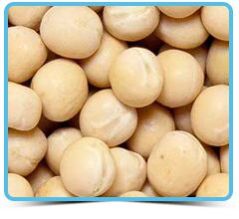
Yellow Peas
Yellow Peas also know as Matar, or White Vatana. Whole Yellow Peas are part of the legume family. Whole Peas are about 1/4 of an inch wide and pale yellow in color. Whole Dried Peas have a history going back some 10,000 years. Originally from the Middle East, Peas soon spread throughout the Mediterranean region and on to India and China. The cultivation of Peas in Europe helped to stave off a famine in England in 1555. Peas are most commonly used in their split form.
...more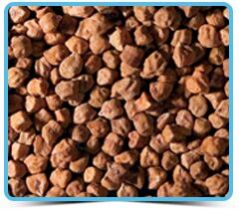
yellow gram
Yellow Gram / Desi Chick Peas also Know as Kala Chana, Bengal Gram, Gram, Chana, Pis Chiche, or Chihu. Desi Chickpeas are a light to dark brown colour. They are in the 6 to 7mm range, with a thick seed coat. About 80% of the Desi Chickpeas produced are split in half to make Chana Dahl, and 80% of this split form are ground into a flour called Besan. Smaller seeded, dark brown angular chickpea (6-7mm) with a thickish seed coat. Seeds have a high fibre content. Used for split pea, Chana dahl or Besan flour, after the hulls are removed. Delicious when eaten fresh from the garden! Also Know as: Kala Chana, Bengal Gram, Gram, Chana, Pois Chiche.
...more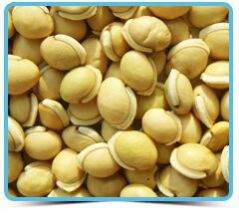
Val Beans
Val Beans sometimes called 'butter beans' because of its starchy and buttery texture, vaal has a delicate flavour that complements a wide variety of dishes. You will find them in various shapes and sizes, ranging from creamish flat long beans, broad hard beans to off white oval shaped dal. This versatile ingredient finds its way commonly in Maharashtrian, Gujarathi and Parsi kitchens in traditional recipes like Vangi ani Val, Dalimbi, Walor muthia nu shaak, Tittori dal etc. A type of pulse commonly used in foods from India that may be served as sprouts, fresh pods, or as dried beans. This bean grows on a small bush and is picked when the pod is tender if the pod is to be prepared as a fresh vegetable. As the bean matures it is then harvested to be dried for use in growing sprouts or made into ingredients for side dishes, main dishes, salads, and soups. The dried val bean is light tan in color and provides a slightly bitter nutty flavor when cooked. It is a good bean to combine with ginger or coconut.
...more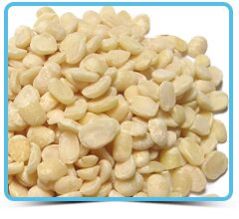
Urad Dal
Split urad dal retains the skins and also has a strong flavor. Skinned and split urad dal are creamy white and somewhat bland. The dal is boiled and has an unusual mucilaginous texture. Ground into flour or paste, it is also extensively used in culinary preparation like dosa, idli, vada, and papad. When used this way, the white lentils are usually used. The white lentils are called "ulundhu" in Tamil. It has creamy white interiors, used in cooking across South Asia. Urad dal is used on a daily basis in South Indian houses to make batters for idlis and dosas and is also an important ingredient in tempering for most South Indian dishes This tastes delicious when cooked dry with fried garlic/onion. People also prepare "Vadas" out of it by soaking the dal in water for 8 hours and then grinding it to a paste and then deep fry making the Vadas in circle/ round / or "D" shape and eat with Dahi or curd. Also the Vadas with a circle and a hole in between is prepared specially in south India and eaten with "Sambhar" i.e. "Sambhar Vadas".
...more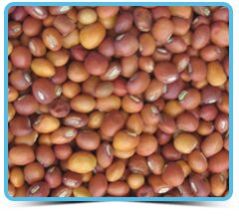
toor whole
Toor is the whole version of toor dal, also known as Pigeon Peas, whole red gram or whole arhar. Pigeon peas are nutritionally important, as they contain high levels of protein and the important amino acids. Toor Whole are both a food crop (dried peas, flour, or green vegetable peas) and a forage/cover crop. In combination with cereals, pigeon peas make a well-balanced human food. The dried peas may be sprouted briefly, then cooked, for a flavor different from the green or dried peas. Sprouting also enhances the digestibility of dried pigeon peas via the reduction of indigestible sugars that would otherwise remain in the cooked dried peas.
...more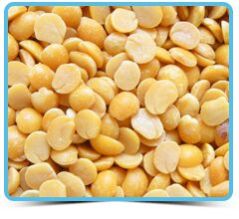
Toor Dal
Toor Dal also known as arhar dal, tuvar dal or yellow spilt peas. It is this split dal widely used for Gujrati dals, puran poli and lots of other tasty variety of dish. Toor dal/dahl is the most popular lentil in India they are also called Thuvaram paruppu or kandhi pappu. Toovar dal exhibits a thick gelatinous / meaty consistency. They take a little longer to cook than moong or masoor dal / dahl. Whole toor lentils are yellow with tan jackets, but they're usually sold skinned and split. They have a mild, nutty flavor, and they're often cooked as a side dish or ground into flour. They're sometimes sold with an oily coating, which you should rinse off. Look for them at Indian markets.
...more
Split Dals
Dals are cornerstone to India's meals as they are an inexpensive way of infusing proteins, fiber, and body-building nutrients to one's diet, vegetarian or otherwise. These common-to-find peas are easy-to-cook and do not require any presoaking. The spicing techniques in this recipe hail from the southeastern region of India where roasting spices to yield nutty-hot flavors are key to create a layered experience. I have simplified the number of spices used but have kept to its authenticity in terms of assertiveness and balance. Be sure to have some steamed white rice to absorb all that saucy goodness. Oh, and best of all, no added fat!
...more
Red Kidney Beans
Both dried and canned kidney beans are available throughout the year. Dried beans are generally available in prepackaged containers as well as in bulk bins. True to their name, these popular beans are kidney shaped and are especially good in simmered dishes where they absorb the flavors of seasonings and the other foods with which they are cooked. Kidney beans are a very good source of cholesterol-lowering fiber, as are most other beans. In addition to lowering cholesterol, kidney beans' high fiber content prevents blood sugar levels from rising too rapidly after a meal, making these beans an especially good choice for individuals with diabetes, insulin resistance or hypoglycemia. When combined with whole grains such as rice, kidney beans provide virtually fat-free high quality protein. But this is far from all kidney beans have to offer. Kidney beans are an excellent source of the trace mineral, molybdenum, an integral component of the enzyme sulfite oxidase, which is responsible for detoxifying sulfites. Sulfites are a type of preservative commonly added to prepared foods like delicatessen salads and salad bars. Persons who are sensitive to sulfites in these foods may experience rapid heartbeat, headache or disorientation if sulfites are unwittingly consumed. If you have ever reacted to sulfites, it may be because your molybdenum stores are insufficient to detoxify them.
...more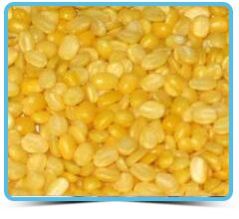
Moong Dal
With their skins removed, moong beans are light yellow in color. These are moong beans that have been skinned and split, so that they're flat, yellow, and quick-cooking. They're relatively easy to digest. They are made into moong beanpaste by de-hulling, cooking, and pulverizing the beans to the consistency of a dry paste. The paste is sweetened and is similar in texture to red bean paste though the smell is slightly more bean-like. In several Asian countries, de-hulled moong beans and moong bean paste are made into ice creams or frozen ice pops and are very popular dessert items. Moong dal khichdis and vadas are quite popular. Moong dal can be used as stuffings.
...more
Masoor Dal
Masoor dal is probably the most commonly used Dal in India. It is basically the split lentil without skin and is red in color. It does not need soaking prior to cooking as it is a "soft" Dal and cooks quickly. When cooked , Masoor dal turns a soft golden color. With 26% protein, lentils have the third-highest level of protein, by weight, of any plant-based food after soybeans and hemp. Masoor dal is an important part of the diet in many parts of the world, especially in the Indian subcontinent which has large vegetarian population. The seeds have a short cooking time (especially for small varieties with the husk removed, such as the common red lentil) and a distinctive earthy flavor. Use masoor to make dhal, the classic Indian dish. Usually, they are boiled to a stew-like consistency with vegetables and then seasoned with a mixture of spices to make many side dishes, which are usually served over rice or with rotis.Masoor dal are used to prepare an inexpensive and nutritious soup all over Europe and North and South America, sometimes combined with some form of chicken or pork. They are frequently combined with rice, which has a similar cooking time to prepare khichdi.
...more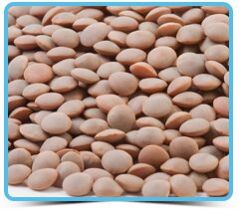
Lentils
Lately lentils have become a tasty staple in our diet. Low in calories and high in nutrition, lentils are the perfect legume to eat in the summer in salads, spreads, for crudite and crackers, and as an item on a vegetarian dinner plate. I always gravitate towards foods that are easy to cook, and lentils are a hassle-free compliment to any meal. Nutty and earthy in flavor, lentils have a high nutritional value that anyone can benefit from by incorporating this healthy legume into their diet. Eat lentils and reap their health benefits including: Lower Cholesterol : Lentils help to reduce blood cholesterol since it contains high levels of soluble fiber. Lowering your cholesterol levels reduces your risk of heart disease and stroke by keeping your arteries clean. Heart Health : Several studies have shown that eating high fiber foods like lentils reduces your risk of heart disease. Lentils are also a great source of folate and magnesium, which are big contributors to heart health. Folate lowers your homocysteine levels, a serious risk factor for heart disease. Magnesium improves blood flow, oxygen and nutrients throughout the body. Low levels of magnesium have been directly associated with heart disease, so eating lentils will keep your heart happy! Digestive Health : Insoluble dietary fiber found in lentils helps prevent constipation and other digestive disorders like irritable bowel syndrome and diverticulosis. Stabilized Blood Sugar : Adding to the many benefits of fiber, soluble fiber traps carbohydrates, slowing down digestion and stabilizing blood sugar levels. This can be especially helpful for those with diabetes, insulin resistance or hypoglycemia. Good Protein : Of all legumes and nuts, lentils contain the third-highest levels of protein. 26 percent of lentil’s calories are attributed to protein, which makes them a wonderful source of protein for vegetarians. Increases Energy : Lentils increase steady, slow-burning energy due its fiber and complex carbohydrates. Lentils are also a good source of iron, which transports oxygen throughout your body and is key to energy production and metabolism. Weight Loss : Although lentils include all these beneficial nutrients like fiber, protein, minerals and vitamins, they are still low in calories and contain virtually no fat. One cup of cooked lentils only contains about 230 calories, but still leaves you feeling full and satisfied.
...more
Green Peas
We don't usually think about green peas as an exotic food in terms of nutrient composition—but we should. Because of their sweet taste and starchy texture, we know that green peas must contain some sugar and starch (and they do). But they also contain a unique assortment of health-protective phytonutrients. One of these phytonutrients—a polyphenol called coumestrol has recently come to the forefront of research with respect to stomach cancer protection. A Mexico City-based study has shown that daily consumption of green peas along with other legumes lowers risk of stomach cancer (gastric cancer), especially when daily coumestrol intake from these legumes is approximately 2 milligrams or higher. Since one cup of green peas contains at least 10 milligrams of coumestrol, it's not difficult for us to obtain this remarkable health benefit. The unique phytonutrients in green peas also provide us with key antioxidant and anti-inflammatory benefits. Included in these phytonutrients are some recently-discovered green pea phytonutrients called saponins. Due to their almost exclusive appearance in peas, these phytonutrients actually contain the scientific word for peas (Pisum) in their names: pisumsaponins I and II, and pisomosides A and B. When coupled with other phytonutrients in green peas—including phenolic acids like ferulic and caffeic acid, and flavanols like catechin and epicatechin—the combined impact on our health may be far-reaching. For example, some researchers have now speculated that the association between green pea and legume intake and lowered risk of type 2 diabetes may be connected not only with the relatively low glycemic index of green peas (about 45-50) and their strong fiber and protein content, but also with this unusual combination of antioxidant and anti-inflammatory phytonutrients.
...more
Green Moong
Green Gram or Green Moong is superfood for weight loss and much more. It keeps us full & also helps us lose weight. It has many properties that are beneficial for us especially when we are starving ourselves in the name of being on diet. We can have it in many forms. We can soak it and make a healthy dal to have with roties or brown rice, we can sprout it and make a healthy salad from it. There is also one interesting way that I doubt most are not aware of; we can dry roast the dal and dry grind it into flour to make some healthy and tasty roties / parathas. Now here are some reasons why you should give so much thought to Green Moong: It’s loaded with Goodies: It is rich in Vitamin A, B, C and E and also in many minerals including iron, calcium, and potassium. Not to forget it is a powerful source of vegetarian protein. It good to Shed Some Unwanted Weight: It is considered a healthy weight loss food as it is a low fat food rich in proteins and fibre. It curbs cravings and keep us full for a long time. It detoxifies the body and benefits the metabolism as well as immune system. It’s good for the Heart: It helps to lower the high cholesterol level in the blood system. Regular intake of Green Moong reduces bad cholesterol and improves the flexibility of arteries and veins. It also regulates the blood pressure. Keeps a check on the Blood Sugar Level: Green Moong is full of complex carbohydrates in form of high fibre, which aids digestion. Complex carbs also stabilizes blood sugar and controls its sudden rise after meal, while keeping body’s energy at a balanced level. Green Moong can be highly beneficial for people having a high blood sugar level
...more
Chick Peas
Chick Peas have a delicious nutlike taste and a texture that is buttery, yet somewhat starchy and pasty. A very versatile legume, they are a noted ingredient in many Middle Eastern and Indian dishes such as hummus, falafels and curries. While many people think of chickpeas as being in beige in color, other varieties feature colors such as black, green, red and brown. Health Benefits of Chickpeas: Fiber Advantage and Weight Loss: Like other beans, Chickpeas, are rich in both soluble and insoluble dietary fiber. Soluble fiber forms a gel-like substance in the digestive tract that snares bile (which contains cholesterol) and ferries it out of the body. Research studies have shown that insoluble fiber not only helps to increase stool bulk and prevent constipation, but also helps prevent digestive disorders. Protein for Vegetarians: Chickpeas are a good source of protein. Combined with a whole grain such as whole-wheat protein, they provide amount of protein comparable to that of meat or dairy foods without the high calories or saturated fats. Manganese for Energy Production: Garbanzos are an excellent source of the trace mineral manganese, which is an essential cofactor in a number of enzymes important in energy production and antioxidant defenses. Just one cup of garbanzo beans supplies 84.5% of the daily value for this mineral. Iron Boost: Garbanzos can boost your energy because of their high iron content. This is particularly important for menstruating women, pregnant or lactating women and growing children. Iron is an integral component of hemoglobin, which transports oxygen from the lungs to all body cells, and is part of key enzyme systems for energy production and metabolism. Stabilizing Blood Sugar and Low Glycaemic Index (GI): Soluble fiber helps stabilize blood sugar levels. If you have insulin resistance, hypoglycemia or diabetes, beans like garbanzos can help you balance blood sugar levels while providing steady, slow-burning energy. They have low GI value of 28 – 32 means the carbohydrate in them is broken down and digested slowly. This is helpful for weight loss as it controls appetite. Heart Healthy: Regular intake of Chickpeas can lower LDL (bad) and total cholesterol. Garbanzos contain the significant amounts of folate and magnesium. Folate lowers the levels of the amino acid, homocysteine and strengthens the blood vessels. Studies have found chickpeas lower the risk of heart attack For Women: Garbanzo contain phytochemicals called saponins, which can act as antioxidants. It could lower the risk of breast cancer, protect against osteoporosis and minimizes hot flushes in post-menopausal women. Weight Loss: Due to high fiber content and low GI, chickpeas are excellent for weight loss diets. Salad with chickpeas are tasty and can keep you full longer, controlling the appetite.
...more
Chana Dal
Chana dal is also known as bengal gram. These lentils have a sweet and nutty taste. Chana dal is got from black chickpeas(kala chana). They are spilt and the outer cover is removed. These lentils are also powdered to give besan or gram flour. Chana dal is rich in the best sort of fibre - soluble fibre - which helps to eliminate cholesterol from the body. It is a good source of folate, potassium, copper, phosphorous and manganese. The dal gives high quality protein.
...more
Butter Beans
Val Beans sometimes called 'butter beans' because of its starchy and buttery texture, vaal has a delicate flavour that complements a wide variety of dishes. You will find them in various shapes and sizes, ranging from creamish flat long beans, broad hard beans to off white oval shaped dal. This versatile ingredient finds its way commonly in Maharashtrian, Gujarathi and Parsi kitchens in traditional recipes like Vangi ani Val, Dalimbi, Walor muthia nu shaak, Tittori dal etc. A type of pulse commonly used in foods from India that may be served as sprouts, fresh pods, or as dried beans. This bean grows on a small bush and is picked when the pod is tender if the pod is to be prepared as a fresh vegetable. As the bean matures it is then harvested to be dried for use in growing sprouts or made into ingredients for side dishes, main dishes, salads, and soups. The dried val bean is light tan in color and provides a slightly bitter nutty flavor when cooked. It is a good bean to combine with ginger or coconut.
...more
Black Matpe Beans
Urad Whole Black (Black Matpe Beans Polished) Also called Black Beluga Lentils. Whole Urad daldahl is used more like a chili or stew than a soup or daldahl. These lentil-like beans have black skins covering creamy white interiors. Whole urad dal dahl derive their strong, rich, earthy flavor from the black skins. and have an uncanny ability to absorb flavors. Best when soaked for about 4 hours or overnight. All natural. Friend of the heart. Diets rich in whole grain foods and other plant foods low in total fat, saturated fat and cholesterol, may reduce the risk of heart disease and some cancers
...more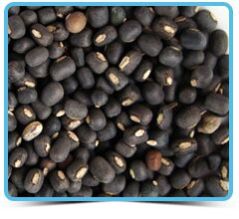
Black Matpe
Urad Whole Black (Black Matpe Beans Polished) Also called Black Beluga Lentils. Whole Urad dal/dahl is used more like a chili or stew than a soup or dal/dahl. These lentil-like beans have black skins covering creamy white interiors. Whole urad dal / dahl derive their strong, rich, earthy flavor from the black skins. and have an uncanny ability to absorb flavors. Best when soaked for about 4 hours or overnight. All natural. Friend of the heart. Diets rich in whole grain foods and other plant foods low in total fat, saturated fat and cholesterol, may reduce the risk of heart disease and some cancers
...more
Black Eye Beans
Black Eye Beans is a plant food, on the Food Guide Pyramid, created by the United States Department of Agriculture, the bean is included in the “Meat and Beans” section because it can be used as a protein source instead of an animal food. In fact, many vegetarians use legumes to substitute for meat when planning meals. One serving of black-eyed peas is equal to one-half cup. One serving of black-eyed peas contains 70 calories, making it a low-calorie option when served without additional condiments. The majority of calories comes from carbohydrate sources (16 grams). Each serving also contains three grams of protein. The beans do not contain any fat or cholesterol. As with all legumes, black-eyed peas are very good fiber sources, providing 4 grams or 16% of the recommended daily value. There are two types of dietary fiber: soluble and insoluble. Beans contain mostly soluble fiber, which can help decrease blood cholesterol levels and therefore may help reduce the risk of heart disease. Soluble fiber may also help patients with diabetes maintain improved blood sugar levels because the fiber helps to slow the rate of absorption of carbohydrate.
...more
Hps Groundnuts

Non Basmati Rice
Be first to Rate
Rate ThisOpening Hours